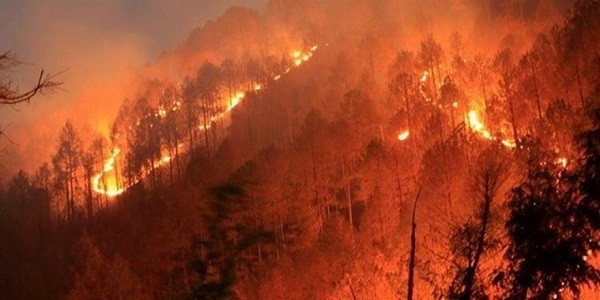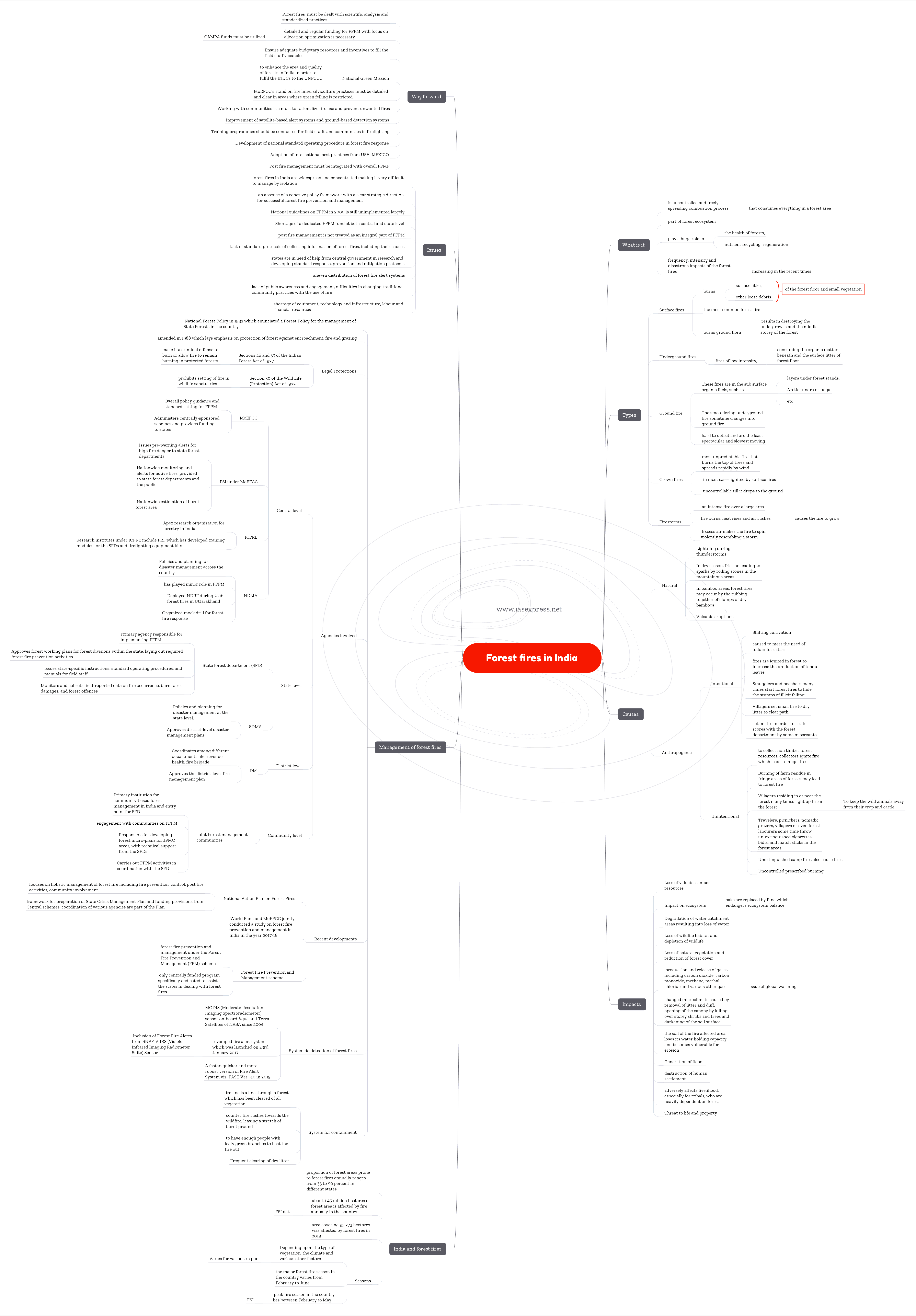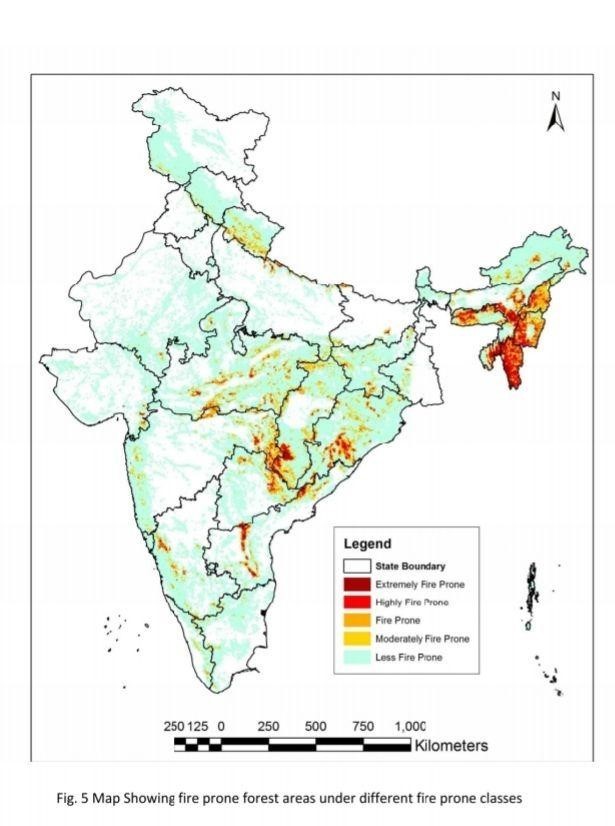[Disaster Series] Forest Fires in India and its Management

The Australian bushfire season has once again put forest fires at the centre of debate as a serious disaster. According to the Fifth Assessment Report of the Intergovernmental Panel on Climate Change, exposure to smoke from landscape fires (including forest fires) is estimated to cause 260,000 to 600,000 premature deaths annually. In India too, forest fires occur almost every year though of varying intensities. It is important to understand the phenomenon of forest fires to tackle it effectively.
This topic of “[Disaster Series] Forest Fires in India and its Management” is important from the perspective of the UPSC IAS Examination, which falls under General Studies Portion.
What are forest fires?
- A forest fire is uncontrolled and freely spreading combustion process that consumes everything in a forest area.
- Forest fires are part of the forest ecosystem from time immemorial and play a huge role in the health of forests, nutrient recycling, regeneration etc. But with the increasing population, climate change and some other reasons, the frequency, intensity and disastrous impacts of the forest fires have been increasing in recent times.
What are the types of forest fires?
Basically, forest fires can be sub-grouped into four types depending upon their nature and size
- Surface fires
It is the type of fire that burns surface litter, other loose debris of the forest floor and small vegetation. Surface fire is the most common forest fire that burns undergrowth and dead material along the floor of the forest. This fire, if became uncontrollable, burns ground flora and results in destroying the undergrowth and the middle storey of the forest.
- Underground fires
The fires of low intensity, consuming the organic matter beneath and the surface litter of forest floor are sub-grouped as underground. It continues to burn for months and destroys vegetative cover.
- Ground fires
These fires are in the subsurface organic fuels, such as layers under forest stands, Arctic tundra or taiga, etc. As such, there is no clear-cut distinction between underground and ground fires. The smouldering underground fire sometime changes into the ground fire. These fires are often hard to detect and are the least spectacular and slowest moving.
- Crown fires
Crown fire is the most unpredictable fire that burns the top of trees and spreads rapidly by the wind. These fires are in most cases ignited by surface fires. Since it is over the head, it is uncontrollable until it drops to the ground. It is usually fast-moving so poses grave danger to the firefighter.
- Firestorms
The fire spreading is most rapid in the firestorm, which is an intense fire over a large area. The fire burns, heat rises and air rushes in which causes the fire to grow. Excess air makes the fire to spin violently resembling a storm.
What are the causes of forestfires?
Natural causes
- Lightning during thunderstorms may lead to the occurrence of forest fires.
- In the dry season, friction leading to sparks by rolling stones in the mountainous areas may lead to forest fires. This occurs only when there is considerable combustible material present on the floor.
- In bamboo areas, forest fires may occur by the rubbing together of clumps of dry bamboos.
- Volcanic eruptions can lead to forest fires.
Anthropogenic causes
More than 90% of forest fires are caused by human beings, deliberately or merely due to negligence or accident
Intentional causes
- Shifting cultivation
Most forest fires in India are deliberate which are set by small-scale farmers or landless rural people. In north-eastern India, the practice of slash-and-burn shifting cultivation is the main cause. The most affected areas by slash and burning methods are Arunachal Pradesh, Assam, Manipur, Meghalaya, Mizoram, Nagaland and Tripura
- To get god grass/ fodder crop
Forest fires are intentionally caused to meet the need for fodder for cattle. In the country, most of the area which is officially classified as permanent pasture is virtually devoid of grass.
- Flush for tendu leaves
In central India, fires are ignited in the forest to increase the production of tendu leaves. Tendu leaves collectors set fires in the summer months to promote a better flush of
leaves.
- To conceal illicit felling
Smugglers and poachers many times start forest fires to hide the stumps of illicit felling. The poachers use forest fires for terrorizing wild animals and hunting too
- Cleaning of paths
Villagers set small fire to dry litter to clear path.
- To settle scores
forests are sometimes also set on fire in order to settle scores with the forest department by some miscreants.
Unintentional causes
- Collection of Non-timber Forest produce
To facilitate collection of above, the collectors ignite a fire, which accidentally may spread in the forest, resulting in a major fire.
- Burning farm residue
After harvest, farmers set fire to their agricultural fields. Many times, when these fires are not put out completely, may spread to the adjoining forest areas
- Protecting crops from wild animals
Villagers residing in or near the forest many times light up the fire in the forest to keep the wild animals away from their crops and cattle. Sometimes when this fire is not
put out completely, it may result in a disastrous forest fire.
- Careless travelling
Travelers, picnickers, nomadic grazers, villagers or even forest labourers some time throw un-extinguished cigarettes, bidis, and match sticks in the forest areas. Un-extinguished campfires of trekkers, labour camps, nomads moving through the forest with their animals or the fires of roadside charcoal panniers, when not put out properly lead to devastating forest fires.
- Uncontrolled prescribed burning
Just before the onset of the fire-prone season, the forest department does controlled burning in forest areas. Controlled burning is done to burn all the combustible material in the forest before the dry season to prevent major forest fires. Sometimes due to carelessness this fire may spread and result in large inferno.
What are the adverse impacts of forest fires?
- Loss of valuable timber resources
Forest fires bring huge losses to timber and deteriorate its quality. Valuable timber species are adversely affected by the fire. However, the impact of forest fire varies from species to species, depending upon its susceptibility
- Impact on ecosystem
The damaging impact of a forest fire can be seen in the Himalayas. The fires in such areas help in spreading the pine forest at the cost of indigenous oak, which is a threat to the ecological balance in the region.
- Degradation of water catchment areas resulting in loss of water
After a forest fire, soil moisture decreases and litter decomposition becomes negligible. This further creates the possibility of a forest fire. Just after fire, changes in the upper layer of soil make it impervious and reduces water infiltration and water holding capacity of the soil.
- Loss of wildlife habitat and depletion of wildlife
killing wild animals and destruction of their habitat is another effect of fire.
- Loss of natural vegetation and reduction of forest cover
As a result of fires, forest area is turned into ashes and rendered useless.
- Global warming
The production and release of gases including carbon dioxide, carbon monoxide, methane, methyl chloride and various other gases, which are released and returned to the atmosphere is a cause of global warming in recent times.
International Centre for Integrated Mountain Development (ICIMOD) working in Hindukush Mountains pins the blame on global warming for creating the conditions that led to fires.
- Microclimate change
The changed microclimate caused by the removal of litter and duff, opening of the canopy by killing over storey shrubs and trees and darkening of the soil surface by residual soot and charcoal can increase insulation causing temperature increase
- Soil erosion
The fire impact on forest floor may vary from just removing the litter to the total consumption of the forest fuel and alteration of the soil mineral structure the soil of the fire affected area loses its water holding capacity and becomes vulnerable for erosion.
- Generation of floods
In the first year after a forest fire, the magnitude of the total water yield suddenly increases in a water body. In some exceptional conditions this may lead to flood also.
- Socio-economic impacts
Fire causes the destruction of human settlement and deterioration of site by subsequently increasing erosion. Forest fire adversely affects livelihood, especially for tribals, who are heavily dependent on forest.
- The threat to life and property
Human life is at risk when fire crews fight fires either at the fire front or from conflict with animals, especially elephants. A forest fire that spreads outside the forest can consume buildings or infrastructure.
India and forest fires
- It is estimated that in India the proportion of forest areas prone to forest fires annually ranges from 33 to 90 percent in different states.
- The area of forest which is prone to forest fires Forest Survey of India in a countrywide study in 1995 estimated that about 1.45 million hectares of forest area is affected by fire annually in the country.
- The Minister for Environment, Forests and Climate Change (MoEFCC) has declared that area covering 93,273 hectares was affected by forest fires in 2019.
Forest fire seasons
- Depending upon the type of vegetation, the climate, and various other factors, the fire season varies from one part to another. Though the major forest fire season in the country varies from February to June, even some forests are not safe from fires throughout the year.
- The forest fire data compiled by FSI in two consecutive years(2005-06 and 2006-07) also helps in identifying the crucial period of forest fire in different States of the country. The data indicate that peak fire season in the country lies between February to May.
Management of forest fires in India
- Exact information about deforestation and forest degradation in the country, though very limited, yet whatever data available, predicts a very sad situation about forest health.
- The first progressive step taken in this regard was the formulation of NationalForest Policy in 1952 which enunciated a Forest Policy for the management of State Forests in the country.
- The National Forest Policy was amended in 1988 which lays emphasis on protection of forest against encroachment, fire, and grazing.
Legal protections
- Sections 26 and 33 of the Indian Forest Act of 1927 make it a criminal offense to burn or allow fire to remain burning in protected forests.
- Section 30 of the Wild Life (Protection) Act of 1972 prohibits the setting of fire in wildlife sanctuaries.
Agencies involved in Forest fire prevention and management
Central level
- Ministry of Environment, forest and climate change
- Overall policy guidance and standard-setting for FFPM
- Administers centrally-sponsored schemes and provides funding to states
- FSI under MoEFCC
- Issues pre-warning alerts for high fire danger to state forest departments nationwide.
- Nationwide monitoring and alerts for active fires, provided to state forest departments and the public.
- Nationwide estimation of burnt forest area
- ICFRE
- Apex research organization for forestry in India
- Research institutes under ICFRE include FRI, which has developed training modules for the SFDs and firefighting equipment kits
- NDMA
- Policies and planning for disaster management across the country
- So far, has played minor role in FFPM
- Deployed NDRF during 2016 forest fires in Uttarakhand
- Organized mock drill for forest fire response
State Level
- State forest department (SFD)
- Primary agency responsible for implementing FFPM
- Approves forest working plans for forest divisions within the state, laying out required forest fire prevention activities
- Issues state-specific instructions, standard operating procedures, and manuals for field staff
- Monitors and collects field-reported data on fire occurrence, burnt area, damages, and forest offences in forest divisions across the state
- SDMA
- Policies and planning for disaster management at the state level.
- Approves district-level disaster management plans
District Level
- DM
- Coordinates among different departments like revenue, health, the fire brigade in the event of a large fire
- Approves the district-level fire management plan
Community-level
- Joint Forest management communities
- Primary institution for community-based forest management in India and the entry point for SFD
- engagement with communities on FFPM
- Responsible for developing forest micro-plans for JFMC areas, with technical support from the SFDs
- Carries out FFPM activities in coordination with the SFD and may organize labour from the local community for clearing fire lines, conducting controlled area burning, seasonal firewatchers, etc.
Recent developments
- National Action Plan on Forest Fires
The NAPFF focuses on holistic management of forest fire including fire prevention, control, post-fire activities, community involvement etc. The framework for the preparation of State Crisis Management Plan and funding provisions from Central schemes, coordination of various agencies are part of the Plan.
- The World Bank and MoEFCC jointly conducted a study on forest fire prevention and management in India in the year 2017-18.
- Forest Fire Prevention and Management scheme
The MoEFCC provides for forest fire prevention and management under the Forest Fire Prevention and Management (FPM) scheme.
The FPM is the only centrally funded program specifically dedicated to assist the states in dealing with forest fires.
System for detection of forests
- Forest Survey of India has been alerting State Forest Departments of forest fire locations detected by the MODIS (Moderate Resolution Imaging Spectroradiometer) sensor onboard Aqua and Terra Satellites of NASA since 2004
- The revamped fire alert system which was launched on 23rd January 2017 has been christened as “Forest Fire Alert System 2.0”. Inclusion of Forest Fire Alerts from SNPP-VIIRS (Visible Infrared Imaging Radiometer Suite) Sensor with higher resolution as its highlight
- In 2019, it again underwent refurbishment and A faster, quicker and more robust version of Fire Alert System viz. FAST Ver. 3.0 was launched.
System for containment
- A fire line is a line through a forest that has been cleared of all vegetation. Once the fire has burnt all combustibles in the compartment, it vanishes and the neighbouring compartments are saved from the fire.
- The counter fire rushes towards the wildfire, leaving a stretch of burnt ground. When the two fires meet, the blaze gets extinguished.
- Another approach is to have enough people with leafy green branches to beat the fire out. This is practised in combination with fire lines and counter fires.
What are the issues in forest fire management in India?
According to the study report conducted by the World Bank and MoEFCC, the main issues are
- The forest fires in India are widespread and concentrated making it very difficult to manage by isolation.
- There is an absence of a cohesive policy framework with a clear strategic direction for successful forest fire prevention and management (FFPM).
- The National guidelines on FFPM in 2000 are still unimplemented largely.
- Shortage of a dedicated FFPM fund at both central and state level is hurting the FFPM process.
- Post-fire management is not treated as an integral part of FFPM.
- There is a lack of standard protocols for collecting information of forest fires, including their causes.
- The states are in need of help from central government in research and developing standard response, prevention and mitigation protocols.
- In some states there more than 2,000 users registered with FSI’s Forest Fire Alert System, while in others there are fewer than a dozen.
- There is a lack of public awareness and engagement, difficulties in changing traditional community practices with the use of fire.
- Forest department faces a shortage of equipment, technology and infrastructure, labour and financial resources
Way forward
- The forest fires are very destructive both in short and long term viewpoint. It must be dealt with scientific analysis and standardized practices.
- Providing detailed and regular funding for FFPM with focus on allocation optimization is necessary. The CAMPA funds must be utilized.
- Ensure adequate budgetary resources and incentives to fill the field staff vacancies
- The National Green Mission is an important program to enhance the area and quality of forests in India in order to fulfill the INDCs to the UNFCCC.
- MoEFCC’s stand on fire lines, silviculture practices must be detailed and clear in areas where green felling is restricted.
- Working with communities is a must to rationalize fire use and prevent unwanted fires.
- Improvement of satellite-based alert systems and ground-based detection systems.
- Training programmes should be conducted for field staffs and communities in firefighting.
- The development of national standard operating procedures in forest fire response will go a long way in integrating forest fire management in the country.
- International best practises from countries like Mexico, USA must be adopted.
- Post fire management is an important filed that must be integrated into overall FFMP.
Practice Question for Mains
Forest fires in India are a major menace. Explain the institutional strategy and actions along with their lacunae. (250 words)



